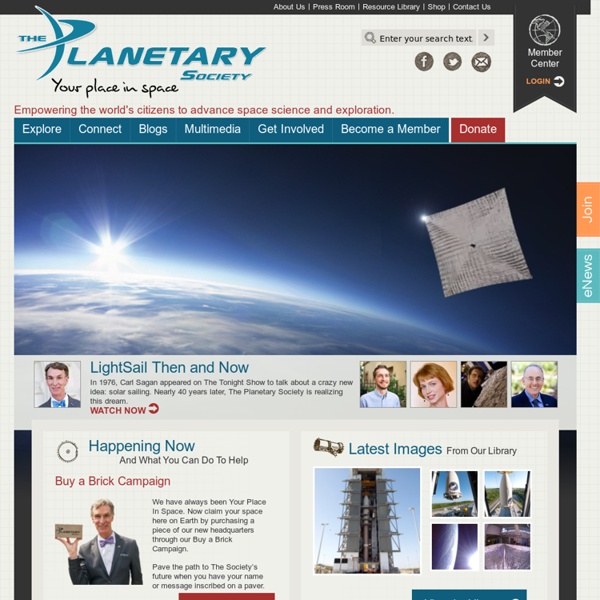



Astronomy Picture of the Day Discover the cosmos! Each day a different image or photograph of our fascinating universe is featured, along with a brief explanation written by a professional astronomer. 2016 April 15 Mercury and Crescent Moon Set Image Credit & Copyright: Miguel Claro (TWAN, Dark Sky Alqueva) Explanation: Innermost planet Mercury and a thin crescent Moon are never found far from the Sun in planet Earth's skies. Tomorrow's picture: Heliopause Electrostatic Rapid Transit System Authors & editors: Robert Nemiroff (MTU) & Jerry Bonnell (UMCP)NASA Official: Phillip Newman Specific rights apply.NASA Web Privacy Policy and Important NoticesA service of:ASD at NASA / GSFC& Michigan Tech.
Interactive 3D model of Solar System Planets and Night Sky Universe in a box: formation of large-scale structure The movie stills pictured above illustrate the formation formation of clusters and large-scale filaments in the Cold Dark Matter model with dark energy. The frames show the evolution of structures in a 43 million parsecs (or 140 million light years) box from redshift of 30 to the present epoch (upper left z=30 to lower right z=0). Click to see the full-resolution version of each panel. At the initial epoch (z=30), when the age of the Universe was less than 1% of its current age, distribution of matter appears to be uniform. You can download the movie as an MPEG movie: full size (10Mb), half size (1.3Mb) The same simulation but with a rotating box (3D geometry of the filaments can be appreciated better) an animated gif: half size (5Mb), quarter size (1Mb) MPEG movie: full size (9Mb) half size (1Mb)
Astronomy Magazine - Interactive Star Charts, Planets, Meteors, Comets, Telescopes Bad Astronomy Well now, this is an interesting discovery: astronomers have found what looks like a "super-Earth" – a planet more massive than Earth but still smaller than a gas giant – orbiting a nearby star at the right distance to have liquid water on it! Given that, it might – might – be Earthlike. This is pretty cool news. We’ve found planets like this before, but not very many! Now let me be clear: this is a planet candidate; it has not yet been confirmed. The star is called HD 40307, and it’s a bit over 40 light years away (pretty close in galactic standards, but I wouldn’t want to walk there). Massive planets tug on their star harder, so they’re easier to find this way. In this case, HD 40307 was originally observed a little while back by HARPS, and three planets were found. We don’t know how big the planet is, unfortunately. That’s exciting because of the prospect for life. Here’s a diagram of the system as compared to our own: Image credits: ESO/M. Related Posts:
Space Science - ESA makes the Sun available to everyone A mega-filament erupts on the Sun as seen on JHelioviwer ESA makes the Sun available to everyone 14 December 2010 New software developed by ESA makes available online to everyone, everywhere at anytime, the entire library of images from the SOHO solar and heliospheric observatory. A solar prominence in JHelioviewer JHelioviewer is new visualisation software that enables everyone to explore the Sun. More than a million images from SOHO can already be accessed, and new images from NASA’s Solar Dynamics Observatory are being added every day. A prominence arcs up from the solar surface. Using this new software, users can create their own movies of the Sun, colour the images as they wish, and image-process the movies in real time. “We wanted to make it easy to view solar images from different observatories and instruments, and to make it easy to make movies,” says Daniel Müller, ESA SOHO Deputy Project Scientist. A prominence twists above the solar surface. For more information, click here
Galaxy Photography, Images by Jason Ware Physics To Go: Explore Physics on your own Books on Demand GmbH: Home The James Webb Space Telescope